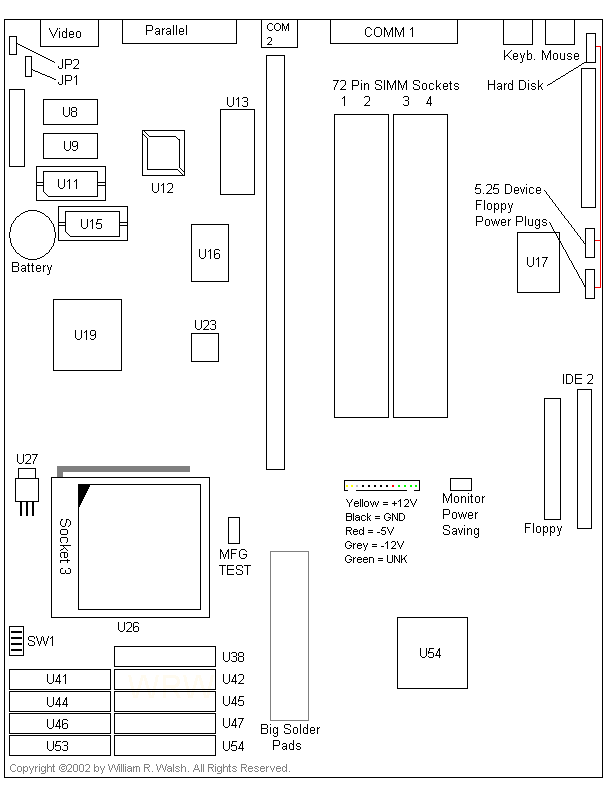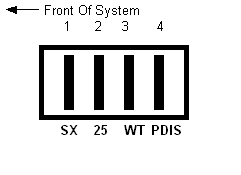|
194-164 IBM Educational Computer, IBM EduQuest Fifty-Five
EduQuest Fifty-Five Photo
eduq_05g.exe Flash BIOS update, revision 05G (self-extracting).
Eduquest55.zip EduQuest Fifty-Five specific files (from Andrew Lawton)
Eduquest_55_School_Box.zip EduQuest "Schoolbox"
Specification
Planar Outline
Switch Block (SW1)
VRAM Sockets & Video Capabilities
Flash BIOS Update
Other Supporting Files
EduQuest "Schoolbox"
Based on content by William R. Walsh (original HERE). Edited by Major Tom.
Specification
Offered processor options:
486 SX 33, 486 SX2 25/50, 486 DX 33, 486 DX2 25/50, 486DX2-33/66, 486 DX4 33/100
Planar

Battery CR2032 CMOS battery
JP1 Power On Password Clear
JP2 see below
SW1 switch block
U8,9 2x512K VRAM
U11,15 VRAM Upgrade Socket
U12 Intel Flash Chip (BIOS update)
U13 "ROM BIOS"
|
U16 VLSI VL82C114
U17 SMSC FDC37C65 (no 2.88 supp.)
U19 Cirrus Logic 5434 Video
U23 VLSI VL82C003
U26 Socket 3 (ZIF)
U27 Linear Tech LT1085 reg.
U38-53 Cache Sockets (U38 TAG?)
U54 VL82C483
|
Notes:
JP2 1-2 (pin one is pads only) Boot
Block Program, 2-3 Normal Operation (this may have to do with flash BIOS
recovery support)
U13 Marked as U13 ROM BIOS (could be
used for bad flash recovery, this machine supports it)
Big Solder Pads are in an arrangement
that looks like there may have been plans for a VL-bus version of this
EduQuest.
Looks to me like this is a vastly revised planar as compared to the EduQuest
30 and 40 where lots of the design stayed the same with only minor changes. You
really can't compare this planar to the 30 and 40 models.
Missing from this board are a lot of what I consider to have been "vestigial
features" on the 30 and 40 such as the ever present but always empty "Mask ROM"
socket.
Looking at U27 (an LT1085 regulator commonly used for such things) and
seeing no manual voltage switch I am inclined to believe that this board can
automatically detect the voltage requirements of the CPU in use. There is a
jumper not shown above that would let one select between 3.3 and 3.45 volts,
but it is not populated (solder pads only) so that may be automatic as
well.
I'm not sure what the maximum amount of RAM this system can handle is. I
wouldn't be surprised if it took 64MB. It appears to be standard non-parity
stuff.
Switch Block (SW1)

Switches are "ON" when upwards.
SX - Selects an i486SX or 'other' CPU
25 - Selects between 25 and 33MHz base clock speeds
WT - L1 Cache Operation Mode WT = Write-Thru or L1-WB = Level 1 Write Back
(Note: Write Back improves performance drastically but may not be 100%
compatible with certain processors and might increase the risk of data
corruption on system failure.)
PDIS - Unknown (Perhaps it enables or disables parity? For what is unknown...)
VRAM Sockets & Video Capabilities
I popped in two upgrade VRAMs into each socket and powered up. I was more
than a little puzzled when the machine didn't report the new VRAM, but since
they were rather crudely desoldered from another dead board, I figured maybe
some pin straightening might be in order. That did the trick and got the system
seeing all 2MB of installed VRAM.
Video is provided by a Cirrus 5434 accelerator. With 1MB VRAM you can run up
to 256 colors in 1024x768. (Oddly enough 1MB is not enough VRAM for 800x600 at
high color, only 256) With all 2MB installed, you can run at least high color
in all supported modes (640x480 to 1024x768).
It appears that the video BIOS has been customized for the internal monitor,
and all SVGA modes run at 72Hz scan rate. You can connect an external monitor,
though what would change about the video chip's behavior I don't yet know.
System setup has an option to disable the internal display if you're using
modes it wouldn't support.
Flash BIOS
Download the self-extracting file here. This is
the genuine and original IBM file. It will take your EduQuest system from
revision 00G to 05G.
Extraction may need to be done under pure DOS and
not Windows NT, as when run on an NT system, no keyboard input to the program
was possible.
Warning: Though most BIOS flash operations go as
planned, errors are possible due to power failures, problems with the flash
source and other little things that can go wrong. While I don't want to
discourage you from applying this update if you need it, I don't advise
applying it just because it is here and you can. Please make sure that your
machine is in fact an EduQuest Model 55 and make the flash "undo diskette"
prior to updating.
This update is provided on a "use at your own risk" basis. YOU are
responsible for the results of using it, whether good or bad.
This flash update supposedly fixes floppy drive read and write errors.
Other Supporting Files
Andrew Lawton supplied an archive containing several EduQuest Model 55
specific files, including the previously mentioned flash BIOS update. You can
download them here. I have not personally used or
tested them and I have no idea what they are intended for. As such, and as
always, you use them at your own risk.
EduQuest "Schoolbox"
School Box is described as some sort of driver and diagnostic package. So,
naturally, the same disclaimer you've heard several times by now applies.
Strongly. But if you still have an EduQuest 55, you might find it useful. Click
here to download it.
(Originally uploaded in this thread
of discussion. Posted here in the name of preservation and because —
rather amazingly — a link that was posted five years ago and labeled as
"temporary" still worked. Sometimes you just get lucky.)
Ed. Tom: Info sourced from IBM announcement
documents:
EduQuest Schoolbox: The EduQuest Schoolbox is not included with each system
since one Schoolbox can be shared among several system units. The
EduQuest Schoolbox consists of a package of items to complement the basic
system unit. It provides a single common source for software and documentation
that are not ordinarily required with each system for typical standard usage.
It provides a single repository of support function items that may be needed
for advanced or specialized situations.
The EduQuest Schoolbox includes:
- System utilities
- DOS, Windows, and OS/2(R) audio drivers
- DOS, Windows, and OS/2 display drivers
- User Guide
To install some options, you need support available in the EduQuest
Schoolbox. An example is when you want to change video modes or add one of the
EduQuest LAN adapters. You need to ensure that the code and programs in the
EduQuest Schoolbox are available when needed. The Schoolbox is a separately
ordered feature and not included with the basic system unit. It is strongly
recommended that you order one Schoolbox with the initial system. Order
additional copies of the Schoolbox, as desired, to share with multiple
systems.
|